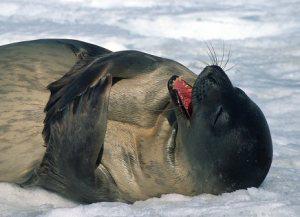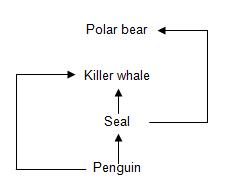
That’s right, David is back on our screens on the 26th of this month to bring us another stunning wildlife series; Frozen Planet. Little snippets of this series have been released to the media and general public over the past few days and it looks to be just as cool as the locations it’s set in! A few species have already made an appearance in wildlife news recently such as crafty killer whales and thieving penguins. To get us all in the mood for the new series, here is a mini food chain detailing why some species make good predators and why some make tasty prey!

Polar bears are one of the apex predators within this food chain. Males are very large and can reach up to 350 – 680 kg and 7.9 – 9.8 ft. in length, with females measuring half that length. Because of their large size, it makes it possible for them to smash into ice dens of seals and tear into prey easily. This is assisted by shorter claws on their feet and their extremely large paws, which can measure approximately 30cm across! Their keen sense of smell also helps them when hunting prey. Polar bears are able detect unburied seals from nearly 1 mile away and buried seals under 3 ft. of snow!
Killer whales are another apex predator that drift in and out of the icy waters surrounding Antarctica and the Artic. They have a varied diet depending on which subspecies they are and their geographical location. Killer whales make excellent predators due to their high intelligence and ability to work as a team. Just recently, new images of killer whales working together to knock a seal off of an ice float have been released. A team of killer whales will rush towards an ice float causing a wave to appear that is powerful enough to knock an unsuspecting seal into the mouth of another member of their pod. They work together like this in many clever hunting situations displaying team work that some think is reinforced by their own ‘culture.’
Weddell seals are the preferred prey of apex predators as they are not as aggressive as crabeater and leopard seals, so the chance of injury by them is not as likely. Weddell seals measure between 8.2 – 11.5 ft. long and can weigh between 400 – 600kg. They are insulated with a thick layer of blubber which not only keeps them warm, but also attracts predators. Their energy rich blubber is vital for them to stay alive because food is so hard to come by. The weddell seal does have a few tricks for avoiding gaping jaws, which are also used when hunting for their own prey. They can dive to depths of approximately 2,300 ft. and can hold their breath for around 80 minutes! That’s a very long time to play hider or seeker!
The Frozen Planet team filmed the Adélie penguin stealing stones from neighbour’s nests to put in their own. Unfortunately for them, penguins make a tasty snack for seals and killer whales (but without the wrapper and bad joke – if you exclude that one!) Penguins may make up the bulk of a predators diet perhaps due to their sheer numbers, making them easier to locate. In the Ross Sea region of Antarctica, there are currently around 5 million Adélie penguins! This may make them an attractive option for many in such a harsh environment.
With these species featured (and I’m sure a lot more) together with the great camerawork from the BBC, I know what I will be doing on Wednesday nights!

